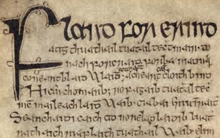Flann Sinna
| Flann Sinna | |
|---|---|
| High King of Ireland | |

Opening lines of Máel Mura Othna's poem Flann for Érinn (Flann over Ireland), from the Great Book of Lecan (RIA MS 23 P 2), 296v
|
|
| Reign | 879–916 |
| Predecessor | Áed Findliath |
| Successor | Niall Glúndub |
| Died | 25 May 916 Lough Ennel, County Westmeath |
| Burial | Clonmacnoise? |
| Spouse | Gormlaith ingen Flainn, Eithne ingen Áeda, Máel Muire ingen Cináeda |
| Issue | Donnchad Donn, Máel Ruanaid, Óengus, Domnall, Conchobar, Áed, Cerball, Gormlaith, Eithne, Lígach, Muirgel |
| Father | Máel Sechnaill mac Máele Ruanaid |
| Mother | Land ingen Dúngaile |
Flann Sinna (English: Flann of the Shannon) (847 or 848 – 25 May 916) was the son of Máel Sechnaill mac Máele Ruanaid of Clann Cholmáin, a branch of the southern Uí Néill. He was King of Mide from 877 onwards and is counted as a High King of Ireland. His mother Land ingen Dúngaile was a sister of Cerball mac Dúnlainge, King of Osraige.
Flann was chosen as the High King of Ireland, also known as King of Tara, following the death of his first cousin and stepfather Áed Findliath on 20 November 879. Flann's reign followed the usual pattern of Irish High Kings, beginning by levying hostages and tribute from Leinster and then to wars with Munster, Ulster and Connacht. Flann was more successful than most kings of Ireland. However, rather than the military and diplomatic successes of his reign, it is his propaganda statements, in the form of monumental high crosses naming him and his father, as kings of Ireland, that are exceptional.
Flann may have had the intention of abandoning the traditional succession to the kingship of Tara, whereby the northern and southern branches of the Uí Néill held the kingship alternately, but such plans were thwarted when his favoured son Óengus was killed by his son-in-law and eventual successor Niall Glúndub, son of Áed Findliath, on 7 February 915. Flann's other sons raised revolts and his authority collapsed.
The Viking Age in Ireland began in 795 with attacks on monasteries on the islands of Rathlin, Inishmurray, and Inishbofin. In the following twenty years raids by Vikings—called "Foreigners" or "Gentiles" in Irish sources—were small in scale, infrequent and largely limited to the coasts. The Annals of Ulster record raids in Ireland in only five of the first twenty years of the 9th century. In the 820s, there are records of larger raids in Ulster and Leinster. The range, size, and frequency of attacks increased in the 830s. In 837, Viking fleets operated on the rivers Boyne and Liffey in central Ireland, and in 839 a fleet was based on Lough Neagh in the north-east.
...
Wikipedia
